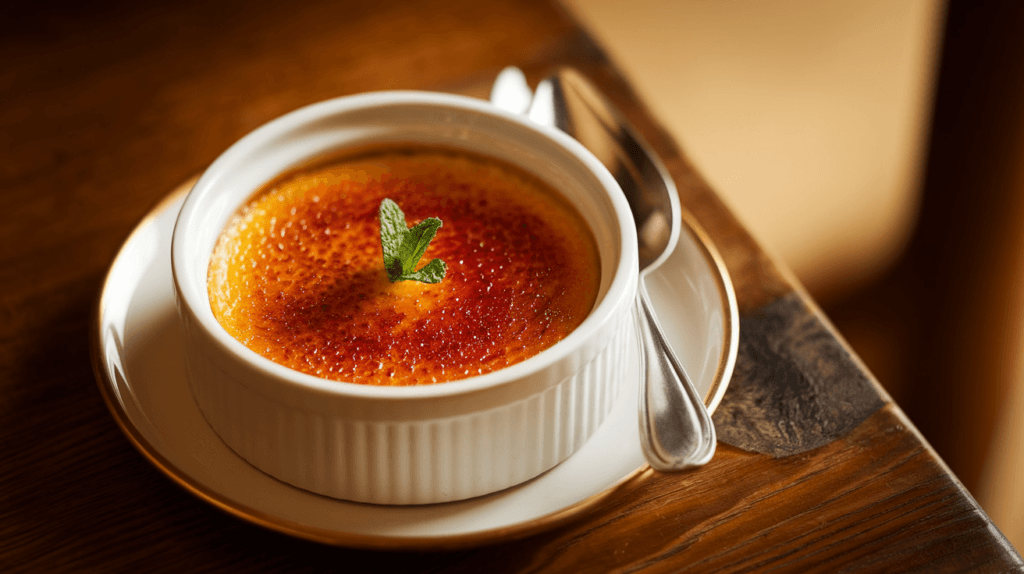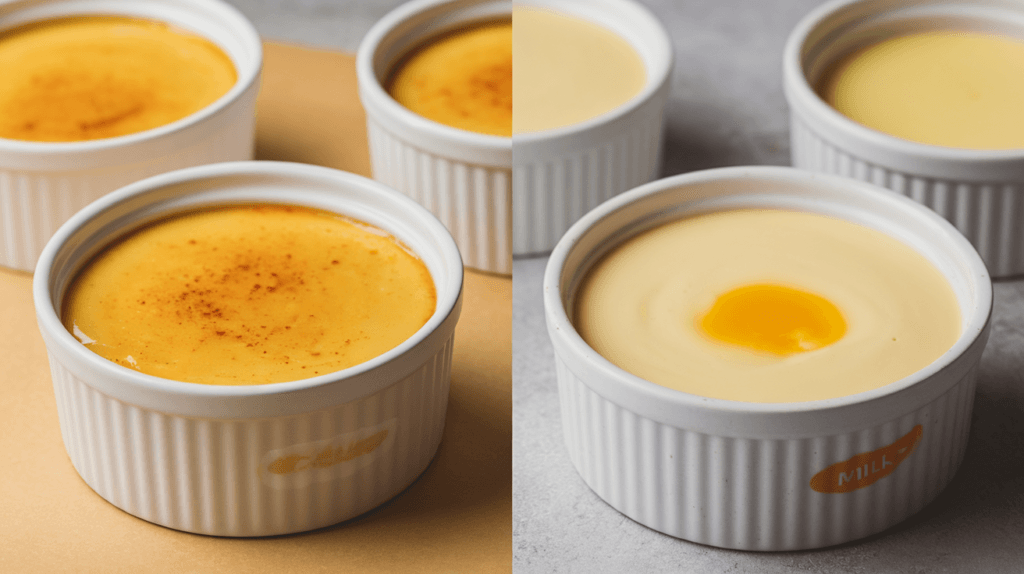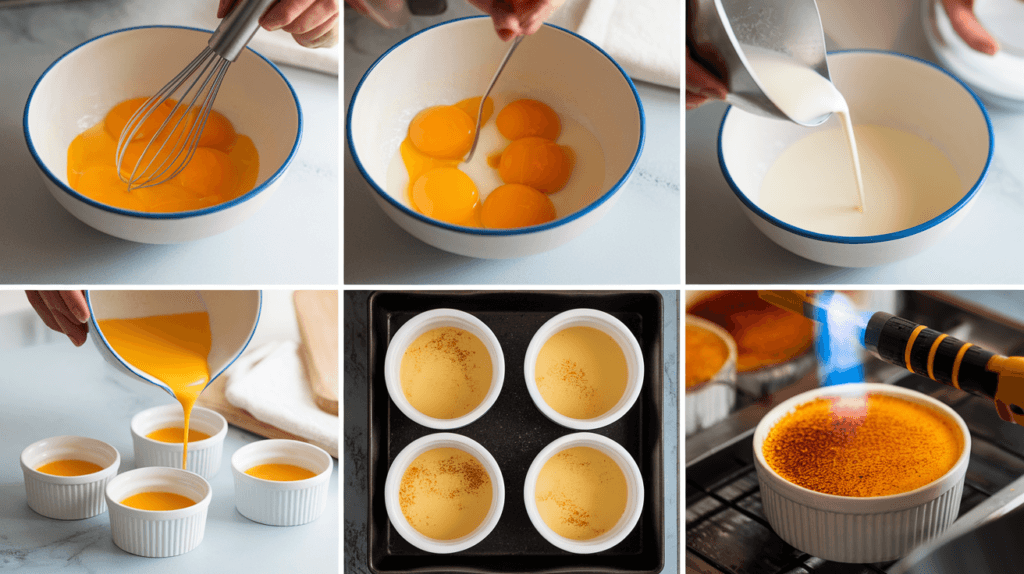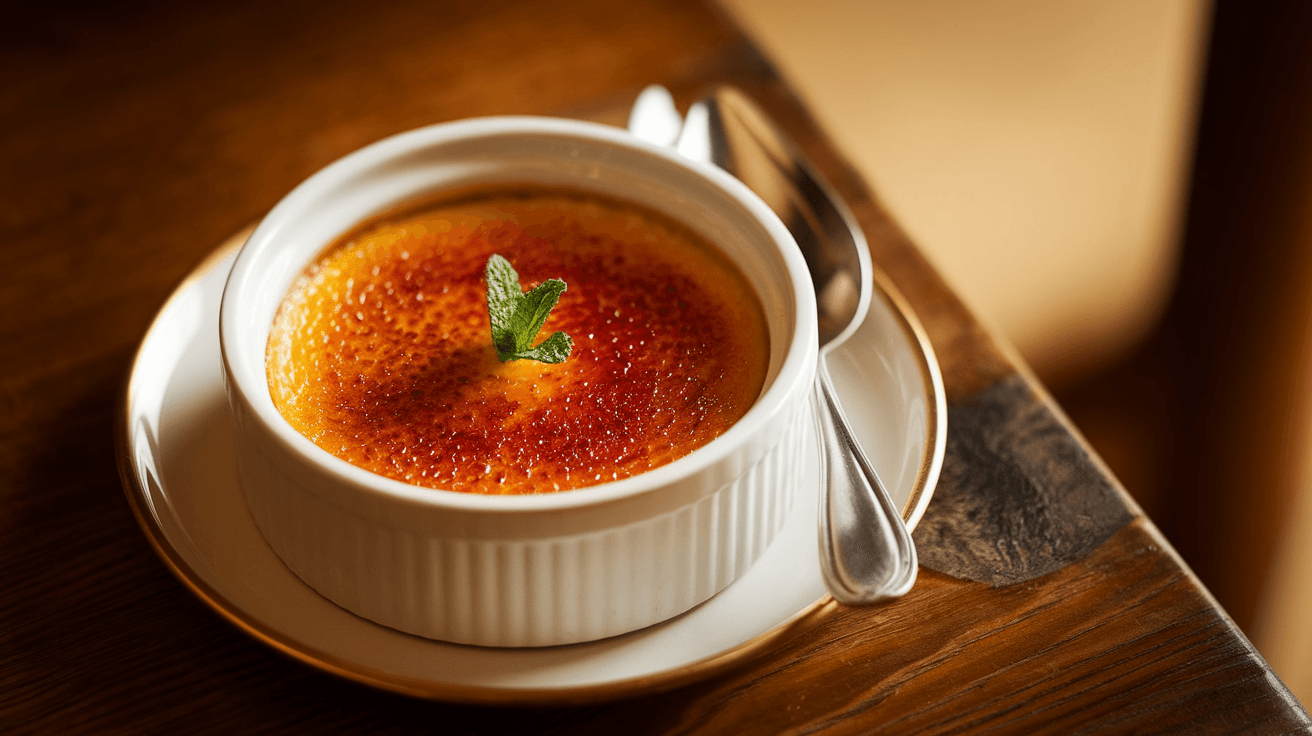Introduction: Can I Use Milk Instead of Cream for Crème Brûlée?

Crème brûlée is a classic French dessert renowned for its luxurious custard base and crisp caramelized sugar topping. Traditionally, the custard is made with heavy cream, which gives the dessert its signature richness and velvety texture. However, there may be instances where you wonder, “Can I use milk instead of cream for crème brûlée?” Whether you’re out of cream, wondering, ‘Can I use milk instead of cream for crème brûlée?’, or seeking a lighter alternative, this substitution is possible—but it requires careful adjustments to maintain the dessert’s beloved qualities.
This article explores the nuances of using milk instead of cream in crème brûlée, including tips on achieving the right texture, preserving the flavor, and ensuring your dessert remains as delightful as the original. From practical cooking strategies to flavor enhancements, you’ll discover how milk can work as a viable substitute without compromising too much on quality.
Understanding Crème Brûlée: Can I Use Milk Instead of Cream?
Traditional Ingredients and Their Roles
Crème brûlée, meaning “burnt cream” in French, is a dessert that embodies simplicity and sophistication. The main ingredients—heavy cream, egg yolks, sugar, and vanilla—combine to create a creamy custard base topped with a crunchy layer of caramelized sugar. Each ingredient plays a vital role:
- Heavy Cream: Provides the custard’s luxurious richness and smooth texture due to its high fat content.
- Egg Yolks: Act as a thickening agent, giving the custard its structure and silkiness.
- Sugar: Adds sweetness to the custard and forms the caramelized topping.
- Vanilla: Enhances the overall flavor profile with its aromatic and warm notes.
The balance of these ingredients ensures the dessert achieves its signature melt-in-your-mouth experience.
Why Cream Is Preferred for Crème Brûlée Recipes
Heavy cream is the cornerstone of crème brûlée because it delivers:
- High Fat Content: Cream’s richness contributes to the velvety texture of the custard, which milk alone cannot replicate.
- Stability During Baking: The fat in cream prevents curdling, ensuring the custard sets perfectly without separating.
- Flavor Depth: Cream has a subtle sweetness and density that enhances the overall taste of the dessert.
When asking, ‘Can I use milk instead of cream for crème brûlée?’, it’s important to note that the substitution may change these characteristics, but with the right modifications, a satisfying result is achievable.
Substituting Milk for Cream in Crème Brûlée: What You Need to Know
Reasons for Substituting Milk
There are several situations where you might consider using milk instead of cream in crème brûlée:
- Dietary Restrictions: Lower fat content in milk can make the dessert more suitable for lighter diets.
- Availability: Milk is a common household staple, while cream may not always be on hand.
- Health Concerns: For those monitoring calorie intake, milk offers a lower-calorie alternative to cream.
Types of Milk to Use When Replacing Cream in Crème Brûlée
The choice of milk significantly impacts the outcome:
- Whole Milk: Best option for substituting cream because it has the highest fat content among milk varieties (around 3.25% fat).
- Low-Fat or Skim Milk: Results in a thinner, less creamy custard due to reduced fat.
- Plant-Based Milks: Options like almond milk, oat milk, or coconut milk can be used but require additional considerations to mimic cream’s properties.
How to Adjust Flavor and Texture When Using Milk Instead of Cream
Replacing cream with milk requires strategic adjustments to retain the dessert’s creamy texture:
- Add Butter: To increase fat content, mix a tablespoon or two of melted unsalted butter with milk.
- Use Extra Egg Yolks: Add one or two more egg yolks to thicken the custard and compensate for the reduced richness.
- Cook Gently: Lower-fat mixtures are more prone to curdling, so bake the custard at a slightly lower temperature and keep an eye on the texture.
Achieving the Right Texture When Using Milk Instead of Cream for Crème Brûlée
The Importance of Fat Content in Custards

Fat is a crucial component in custards like crème brûlée because it provides:
- Creaminess: Higher fat content leads to a smoother, silkier texture.
- Stability: Fat helps bind the ingredients, reducing the risk of separation during baking.
- Richness: The luxurious mouthfeel of classic crème brûlée comes largely from the fat in heavy cream.
When you substitute milk, especially low-fat or skim milk, the lower fat content can lead to a custard that’s thinner and less stable.
Techniques to Compensate for Low Fat
If you’re thinking, ‘Can I use milk instead of cream for crème brûlée?’, maintaining the creamy consistency is achievable with these techniques:
- Adding Butter: Melted unsalted butter can be added to milk to simulate cream’s higher fat content. For example:
- Combine 1 cup of whole milk with 2 tablespoons of melted butter.
- Mix thoroughly to create a richer base similar to cream.
- Increasing Egg Yolks: Egg yolks contribute to the custard’s thickness and richness. Adding an extra yolk or two helps offset the lack of cream. For instance:
- If the original recipe calls for 4 egg yolks, use 5 or 6 when using milk.
- Using a Thicker Milk Alternative:
- Evaporated Milk: This concentrated form of milk is thicker and richer than regular milk, making it a closer substitute for cream.
- Coconut Milk: Full-fat coconut milk provides a creamy consistency and a unique flavor twist.
Comparison of Results
Here’s how different types of milk affect the final texture of crème brûlée:
| Type of Milk | Outcome |
|---|---|
| Whole Milk | Smooth but lighter; slightly less indulgent than cream. |
| Low-Fat Milk | Thin custard; lacks the creamy mouthfeel of the traditional recipe. |
| Skim Milk | Very light and watery; not ideal without significant adjustments. |
| Coconut Milk | Rich and creamy; adds a subtle coconut flavor to the dessert. |
| Almond or Oat Milk | Lighter texture; may need stabilizers like cornstarch for optimal results. |
Practical Considerations When Using Milk
Baking Adjustments
Milk-based custards require careful attention during baking:
- Temperature: Lower the oven temperature by about 10°F (e.g., 300°F instead of 310°F). Milk lacks the stability of cream, so gentle heat helps prevent curdling.
- Baking Time: The custard may set more quickly. Begin checking for doneness 5–10 minutes earlier than the recipe suggests.
- Water Bath: Always bake crème brûlée in a water bath to ensure even cooking and prevent the edges from overcooking while the center sets.
Preventing Curdling
Curdling occurs when proteins in milk or eggs overcook and separate. To avoid this:
- Whisk Slowly: Avoid vigorous whisking, which incorporates air and can lead to an uneven texture.
- Temper the Eggs: Gradually mix warm milk with egg yolks to prevent them from cooking prematurely.
- Monitor the Oven: The custard is done when the edges are set, but the center is still slightly jiggly. Overbaking can cause curdling.
Flavor Impact of Using Milk: Can It Replace Cream in Crème Brûlée?
How Milk Affects the Flavor Profile
Can I use milk instead of cream for crème brûlée?’, the flavor changes subtly when milk is used due to the lower fat content and milk’s lighter nature:
- Milder Taste: Milk lacks the rich, buttery notes of cream, resulting in a custard that’s less indulgent.
- Less Depth: Cream’s natural sweetness and fat enhance the dessert’s complexity, which milk alone cannot fully replicate.
However, these changes aren’t necessarily a disadvantage. For those who prefer a lighter dessert, the use of milk can provide a refreshing alternative.
Enhancing the Flavor
To compensate for the reduced richness, you can boost the flavor of your crème brûlée with additional ingredients:
- Vanilla Bean Pods: Use real vanilla bean seeds instead of extract for a stronger, more aromatic flavor.
- Spices: Add a pinch of cinnamon, nutmeg, or cardamom for a warm, spiced twist.
- Citrus Zest: Lemon or orange zest can introduce a bright, zesty note that complements the lighter custard.
- Flavored Extracts: Consider almond, hazelnut, or coconut extract to add dimension.
These additions not only enrich the flavor but also help the dessert stand out, even without the cream.
Baking Tips for Crème Brûlée with Milk Instead of Cream

Preparing the Custard
- Heat the Milk Carefully:
- Warm the milk gently to avoid scorching.
- Stir constantly to prevent a film from forming on the surface.
- Temper the Eggs:
- Slowly add the warm milk to the beaten egg yolks while whisking continuously.
- This gradual process ensures the eggs don’t scramble.
- Strain the Mixture:
- Use a fine-mesh sieve to remove any egg solids or bubbles for a smoother custard.
Baking with Milk
- Use a Shallow Dish:
- Milk-based custards set more evenly in shallow ramekins due to their thinner texture.
- Adjust Baking Time:
- Check for doneness earlier than usual, as milk custards may cook faster than cream-based ones.
- Water Bath (Bain-Marie):
- Place the ramekins in a larger pan filled with hot water to provide gentle, even heat.
Caramelizing the Sugar
- Choose the Right Sugar:
- Use superfine or granulated sugar for a smooth caramel layer.
- Torch with Precision:
- If you don’t have a kitchen torch, broil the custard for a few minutes. Keep a close watch to prevent burning.
- Cool the Caramel:
- Allow the sugar topping to cool and harden for a satisfying crunch.
Why the Process Matters
Using milk instead of cream requires extra care at each step to ensure the final product retains its appeal. Proper technique allows the custard to develop a smooth texture and a harmonious balance of flavors, even with a lighter base.
Pros and Cons of Using Milk Instead of Cream
Advantages of Substituting Milk
- Lighter Texture: Using milk results in a custard that feels lighter and less heavy, which can appeal to those who prefer a more delicate dessert.
- Lower Calories: Milk contains significantly fewer calories and less fat than cream, making it a healthier alternative for those watching their diet.
- Accessibility: Milk is a household staple, readily available when cream might not be on hand.
- Versatility: The lighter custard base can pair well with fresh fruit toppings or additional flavor infusions like citrus or floral notes.
Disadvantages of Substituting Milk
- Reduced Creaminess: The custard will lack the velvety, rich texture that cream provides, potentially making it less indulgent.
- Flavor Impact: Milk doesn’t have the same depth of flavor as cream, resulting in a simpler taste profile.
- Cooking Challenges: Milk’s lower fat content makes it more prone to curdling or overcooking, requiring greater attention during preparation.
- Thin Consistency: Without adjustments like added butter or extra egg yolks, the custard may turn out too runny.
Alternative Cream Substitutes
If cream isn’t available and you’re hesitant about using plain milk, there are other options to consider that strike a balance between flavor, texture, and availability.
Dairy-Based Alternatives
- Half-and-Half: A mixture of cream and milk, this substitute offers a lower-fat option while retaining some of the richness of cream.
- Adjustments: No significant modifications needed; use it as a direct substitute.
- Evaporated Milk: Thickened milk with some water removed, making it creamier than regular milk.
- Adjustments: Use it as-is for a closer texture to cream.
- Cream Cheese or Mascarpone: Blend a small amount with milk for a creamy custard with a slightly tangy flavor.
Plant-Based Options
- Coconut Milk: Full-fat coconut milk is rich and creamy, providing an excellent substitute for cream. It adds a hint of coconut flavor, which can complement the custard.
- Adjustments: No additional fat or yolks needed.
- Almond Milk or Oat Milk: These lighter options can work but may require a thickening agent like cornstarch.
- Adjustments: Increase egg yolks or add a stabilizer to prevent a watery texture.
- Cashew Cream: Made by blending cashews with water, it’s a plant-based alternative that mimics cream’s richness.
- Adjustments: Use in the same ratio as heavy cream for similar results.
Key Comparison: Cream vs. Substitutes
| Ingredient | Richness | Flavor | Ease of Use | Best For |
|---|---|---|---|---|
| Heavy Cream | High | Buttery, rich | Very easy | Classic crème brûlée |
| Whole Milk | Moderate | Mild, neutral | Requires adjustment | Lighter, less indulgent versions |
| Half-and-Half | Medium-High | Creamy, mild | Easy | Slightly lighter than traditional |
| Coconut Milk | High | Coconut-infused | Easy | Dairy-free alternatives with a unique twist |
| Evaporated Milk | Medium | Sweet, creamy | Very easy | Quick substitutions when cream isn’t available |
Tips for Successful Substitutions
- Experiment with Blends: Combining milk with one of these alternatives (e.g., half milk and half coconut milk) can yield a better balance between texture and flavor.
- Embrace Unique Flavors: Use coconut milk or almond milk to create a non-traditional crème brûlée with a distinctive taste.
- Stick to Whole Milk: If using dairy milk, always choose whole milk for the best results.
FAQs: Can I Use Milk Instead of Cream for Crème Brûlée?
A common question is, ‘Can I use milk instead of cream for crème brûlée?’ The answer is yes, with proper adjustments.
1. Can low-fat milk work in crème brûlée?
Low-fat milk can be used, but it results in a thinner and less creamy custard. To improve the texture, consider adding extra egg yolks or a small amount of melted butter. Whole milk is a better choice if you want a richer result.
2. What’s the best milk alternative for a creamy texture?
Full-fat coconut milk is one of the best substitutes for cream because of its richness and similar fat content. It produces a smooth custard with a slight coconut flavor. Other options like cashew cream or evaporated milk can also work well.
3. Does using milk change the cooking time?
Yes, milk-based custards may set more quickly due to the lower fat content. It’s important to check for doneness earlier than the recipe suggests. Bake until the edges are set, but the center remains slightly jiggly.
4. Can milk be used in other custard recipes?
Absolutely! Milk can replace cream in many custard-based recipes, such as flan, panna cotta, and pastry creams. However, similar adjustments to fat content and flavor may be needed.
5. What’s the difference in calories when using milk vs. cream?
Milk is significantly lower in calories than cream. For example, 1 cup of whole milk contains about 150 calories, while 1 cup of heavy cream has around 800 calories. Substituting milk makes crème brûlée a lighter dessert option.
6. Does milk affect the caramel topping?
No, the caramel topping remains unaffected when using milk instead of cream. The sugar will still caramelize to form a crisp, crackly layer. Just ensure the custard underneath is properly set before caramelizing.
Conclusion
Crème brûlée is a versatile dessert that can be adapted to suit various dietary needs and ingredient availability. While heavy cream is the traditional choice for its richness and creamy texture, milk can be used as a substitute with the right adjustments. Adding butter, increasing egg yolks, or exploring alternatives like coconut milk can help you achieve a custard that’s still delightful, even without cream.
Using milk makes crème brûlée lighter and more accessible, appealing to those looking for a healthier or simpler version of this classic treat. Whether you’re experimenting with plant-based substitutes or simply out of cream, the techniques outlined in this article will ensure your crème brûlée remains smooth, flavorful, and satisfying.
With some creativity and careful preparation, you can confidently create a milk-based crème brûlée that’s a worthy alternative to the traditional recipe. Give it a try, and enjoy the satisfaction of crafting a dessert that’s as adaptable as it is delicious!

